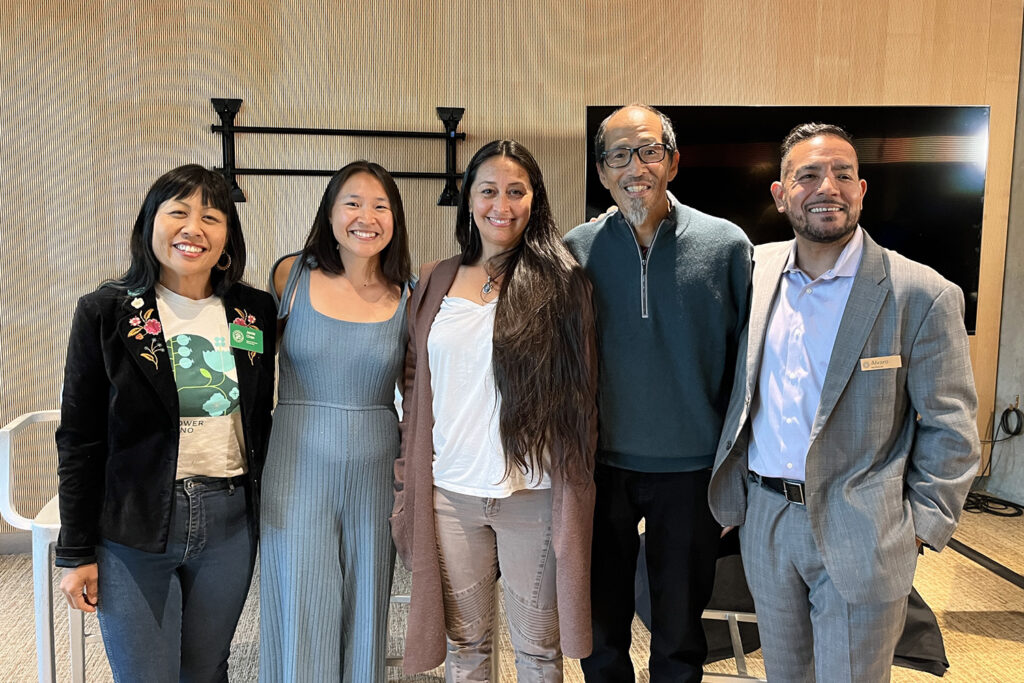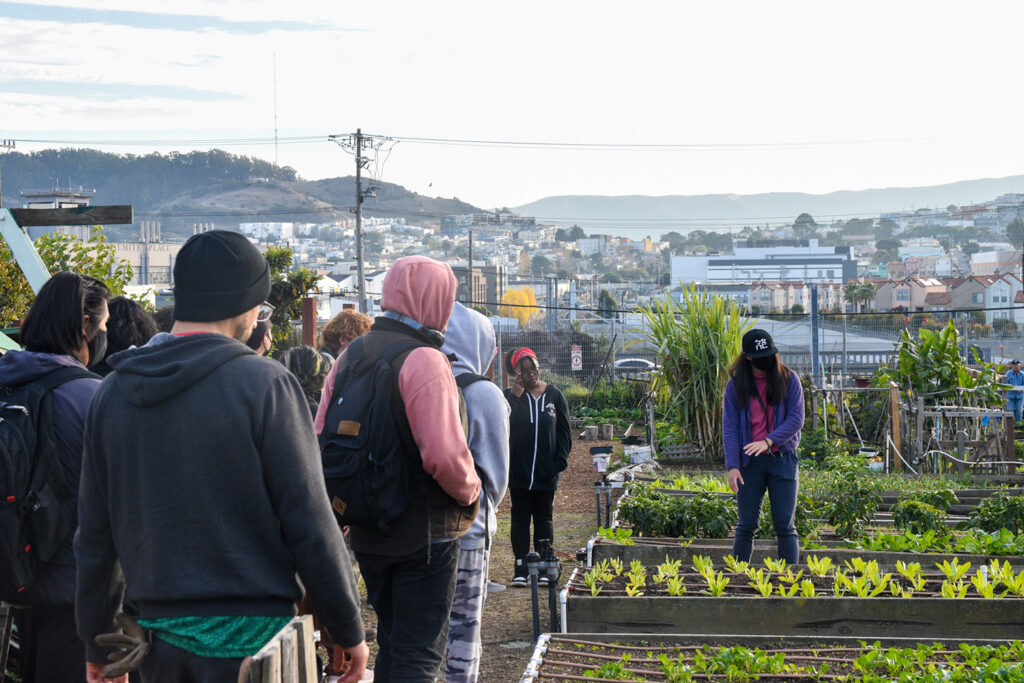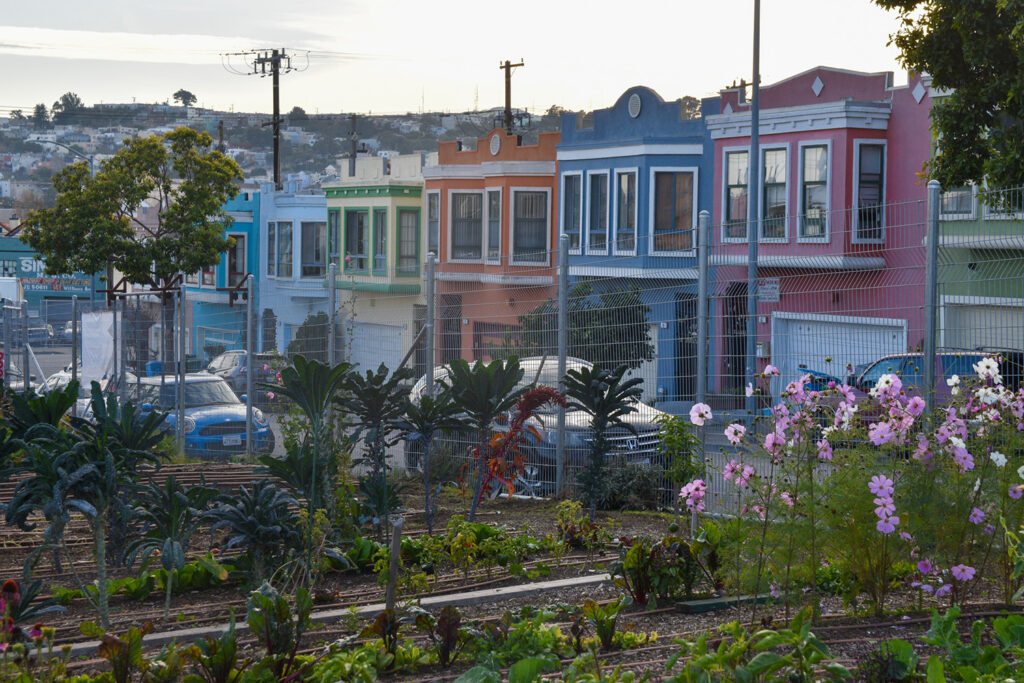How San Francisco Is Reimagining Urban Green Spaces
August 23, 2024

When you imagine urban green spaces you might picture grassy, manicured parks. But green spaces can take many forms: lush and biodiverse farms where neighbors grow food together, school gardens that engage young people in nature, and land projects that restore Indigenous culture and foodways. These spaces are essential for community health and healing, especially for people living in cities who have limited opportunities to connect with the land.
Reimagining San Francisco is an alliance of 40 organizations dedicated to uplifting and expanding these spaces, envisioning a city where people and nature thrive together. At a recent talk cohosted with Foodwise, alliance and community members convened at the California Academy of Sciences to share efforts to cultivate climate-wise, biodiverse, and equitable urban green spaces. Here are a few highlights, and you can watch the full talk here.

Greening urban spaces means honoring our land’s history. San Francisco is built upon stolen, unceded land of the Ramaytush Ohlone people. “A land acknowledgement for me as a remembering of that first relationship,” said Sara Moncada, CEO of The Cultural Conservancy, which leads Native land access projects in San Francisco and the greater Bay Area. “As I stand here as an Indigenous woman, and often have to hold the space for Indigeneity in the room, one of the things that’s most important to me is, first and foremost, to honor the lands beneath my feet. I am a guest here, and being a guest here means that I have a call to be a good human being.”
Restoring people’s connection to the land is healing work. The Cultural Conservancy works to restore connections between ancestral lands and Indigenous people—connections that have been deeply and painfully severed for centuries. “As Indigenous people without access to land and the capacity to re-engage in cultural land-based practices, that impacts everything from cultural identity to language to cultural practice, to foods to seeds, to remembering who you are,” Sara said. “If we can work to reignite that remembering, if we can work to re-engage and work in those reconnections, then we can work to re-engage and rebuild humans. Especially inside of a food justice or food landscape conversation, you can’t go past the San Francisco urban landscape without recognizing Indigenous people are at the bottom of the bottom of all of the access to healthy, clean food. And with that, they have the highest of the highest health disparities. It is something that has to be addressed, and you can ultimately start to address it by simply reconnecting Indigenous people to their traditional foods.”

Transforming urban land into green space requires community organizing. This separation from the land extends to most people who live in city landscapes, which have been polluted and paved over. Ted Fang, founder of Florence Fang Community Farm (San Francisco’s only USDA-registered farm), shared the critical community engagement it took to turn the 1-acre plot atop a CalTrain tunnel into the thriving farm it is today. “When we got this land, it had laid barren for almost 30 years. It was basically a brownfield, blighted with a lot of garbage. It took us two years to pick up all the garbage and spread mulch across the whole acre. In those first couple of weeks, just picking up the garbage off the land made me feel part of the land and like this land belongs to the community.”
Indigenous land management holds climate solutions. Rooted in tending healthy land, soil, and water, Indigenous agricultural practices provide solutions for land restoration and climate change adaptation—such as dry farming techniques, based on Indigenous practices from desert regions. “One of the things that I love about this current wave that we’re in,” Sara said, “is we’re actually elevating our awareness of Indigenous sciences and traditional land practices and their capacity to be relevant in a current modern landscape. How do we address climate mitigation or climate chaos? And can we utilize traditional practice systems to elevate and bring forward those kinds of practices?”
Diverse community foodways create biodiverse green spaces. Florence Fang Community Farm is in the Bayview, one of the most underserved neighborhoods in San Francisco and one of the most diverse. Diversity is a source of the farm’s strength. The farm grows 67 different varieties of produce, reflecting the ethnicities and cultures of the farm’s community. “Our neighborhood is 36% Asian, which is mostly immigrants with limited English proficiency. It’s 26% African American, about 16% Latino, and less than 10% white. Our farm is bringing the community together. We are based on principles of diversity. We have all these people farming together. It’s also intergenerational, having the kids work with the elders. Each party is learning from the other at the same time.”

Cultural relevance is critical for people of all ages and backgrounds. Tiffany Chung, Director of Education at Foodwise, shared about the importance of culture in engaging youth in school gardens through the Foodwise Teens program. Many of the high school students in the program are Latinx, and come from families who recently immigrated to the U.S. This makes it important to have a “cultural tie-in when students visit the school garden for the first time and it seems like an unfamiliar space. We try to grow crops that students might be interested in or are familiar with. When they taste a plant, they realize, ‘Oh, wait, that’s cilantro. That’s something I know.’ It actually creates this sense of familiarity for them and excitement about the garden.”
Urban-rural connections are a form of green space, too. Farmers markets not only feed our cities, but connect city dwellers with regional farmland, seasonality, and the source of our food. Tiffany shared, “If you entertain the idea of a farmers market also being an urban green space, we have a lot of our students in our market, working alongside the farmers. They learn about farming methods, maybe not so directly in the land, but with farmers.” Sara mentioned The Cultural Conservancy’s community revitalization days on farm projects in Sonoma County, which bring urban dwellers out to work on the land and bring food and plants back with them to the city.

Help grow your city’s green spaces. Ted pointed out that there are about 100 community gardens and urban farms in San Francisco, run by the city or independently. Jamie Chan, Director of Programs & Partnerships at the Gardens of Golden Gate Park and a cofounder of Sisterhood Gardens, shared this call to action for anyone looking to support urban agriculture, greener schoolyards, and Indigenous land efforts: “The Reimagining San Francisco Alliance is only as good as its members—so join.” You can support their efforts to make 30% of the city biodiverse green space by 2030 and find volunteer opportunities here.
Some quotes have been edited here for brevity. Watch the full talk here.
Topics: Food access, Foodwise Teens, Talks, Urban farming
